To optimize your nighttime melatonin production, focus on wavelengths like red and near-infrared light. These longer wavelengths support melatonin synthesis and help you relax, improving your sleep quality. Avoid short-wavelength light, especially blue light, in the evening, as it can suppress melatonin levels and disrupt your circadian rhythm. Aim to expose yourself to red light for at least an hour before bedtime for the best results. You can also consider using special light devices designed for this purpose. As you explore further, you'll uncover more strategies to enhance your sleep environment and overall well-being.
Understanding Melatonin Production
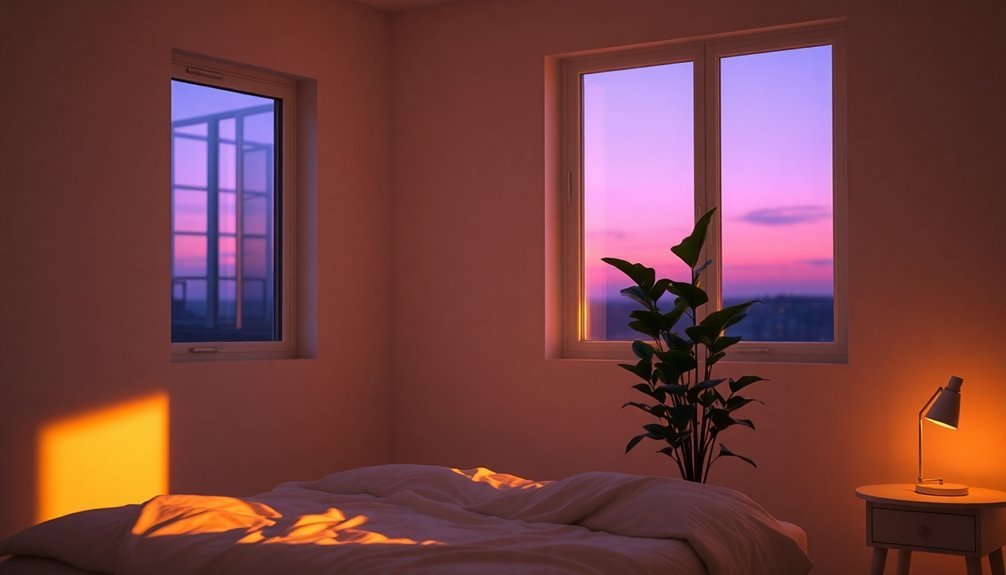
Melatonin production plays an essential role in regulating your sleep-wake cycle and is primarily synthesized in the pineal gland. It all starts with the amino acid L-tryptophan, which you get either from your diet or from breaking down proteins.
The process begins when tryptophan is hydroxylated by tryptophan hydroxylase, creating 5-hydroxytryptophan (5-HTP). This compound is then converted into serotonin through decarboxylation.
Once serotonin's formed, it's transformed into N-acetylserotonin by serotonin N-acetyltransferase, with the help of acetyl-CoA. The final step of melatonin biosynthesis occurs when N-acetylserotonin is methylated by hydroxyindole O-methyltransferase, resulting in the melatonin hormone you need for restful sleep.
The production of melatonin is primarily regulated by the suprachiasmatic nucleus (SCN) in your brain, responding to light-dark cycles. Light exposure suppresses melatonin production, while dim light conditions encourage it.
Regular sleep patterns, a balanced diet rich in nutrients like B vitamins, and avoiding stimulants can greatly influence your melatonin levels. Remember, maintaining a healthy lifestyle will support the natural production of melatonin essential for your sleep health.
Impact of Light Wavelengths
When you're exposed to short-wavelength light, like blue light, you'll notice a significant suppression of melatonin production. This can shift your body's internal clock and affect your sleep. In contrast, red light and longer wavelengths don't disrupt melatonin levels as much, making them a better choice for nighttime exposure. Exposure to blue light in the evening can trick the brain into thinking it is still daytime, further disrupting your circadian rhythms.
Short-Wavelength Light Effects
Short-wavelength light, particularly in the blue spectrum, greatly impacts melatonin production and circadian rhythms. Research shows that short-wavelength light, especially in the range of 470-525 nm, suppresses nocturnal melatonin more effectively than longer wavelengths.
Even low intensities can considerably lower melatonin levels. For instance, simply being exposed to blue light around 460 nm can wildly disrupt your sleep patterns.
Here are some key effects:
- Exposure to blue light can advance your melatonin rhythm by 40-65 minutes.
- The circadian system is more sensitive to short wavelengths, leading to delayed melatonin onset.
- Increased short-wavelength light at night correlates with lower sleep quality.
- Short-wavelength light raises alertness, body temperature, and heart rate, all while suppressing melatonin.
- Consistent exposure damages your natural photic environment, resulting in sleep disturbances.
- The presence of Artificial Light at Night (ALAN) is a growing concern, as it negatively affects many organisms' melatonin production in diverse ecosystems.
To foster better melatonin production and overall sleep quality, it's vital to limit your exposure to short-wavelength light, especially in the evenings.
Prioritizing dim, warm light can help maintain your circadian rhythm and optimize melatonin levels for a restful night's sleep.
Red Light Benefits
How can red light enhance your sleep quality and support melatonin production? Red light wavelengths stimulate melatonin production, promoting better sleep without the suppression seen with blue light. By using red light in the evening, you can help regulate your internal clock and improve your circadian rhythms.
Studies show that red light therapy and photobiomodulation (PBM) can greatly boost melatonin levels, leading to enhanced sleep quality. In fact, replacing white or blue light with red light in your nighttime routine can improve your sleep experience.
When exposed to red light, you reduce stress and anxiety, fostering a relaxed state that's ideal for sleep. Moreover, even exposure to red light during the afternoon can enhance alertness and prepare your body for restful sleep later.
It's crucial to choose products that emit actual red light wavelengths rather than just red-tinted bulbs for the best benefits. Integrating red light exposure into your daily routine, alongside good sleep hygiene practices, can help synchronize your circadian rhythms and support a healthy sleep-wake cycle.
Prioritize red light therapy for a more effective path to restful nights.
Red and Near-Infrared Light
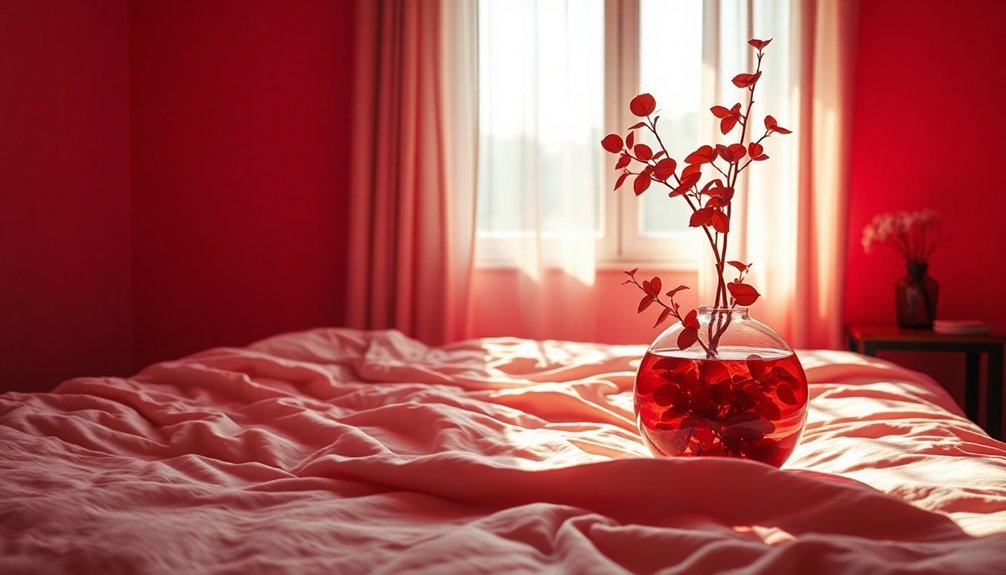
Red and near-infrared light play a pivotal role in promoting melatonin production, particularly by enhancing mitochondrial function within cells. These wavelengths stimulate cellular processes, so they can boost melatonin levels without directly impacting the pineal gland.
Instead, the benefits primarily occur at the cellular level, where extrapineal melatonin production can greatly contribute to your overall melatonin levels and sleep quality.
When you use red and near-infrared light therapy, you can enjoy several advantages:
- Supports activation of key enzymes, like cytochrome C oxidase.
- Aligns with the natural rise in melatonin levels, enhancing your sleep patterns.
- Reduces sleep onset latency and improves sleep efficiency.
- Less disruptive to sleep-wake cycles compared to blue or white light.
- Safe for nighttime use, as it doesn't greatly affect circadian rhythms.
Using red light, especially at the right intensity, can lead to better sleep experiences.
For those seeking to enhance sleep quality, integrating red and near-infrared light therapy into your evening routine can be a game-changer, especially when combined with good sleep hygiene practices.
Optimal Timing for Light Exposure
Understanding the ideal timing for light exposure is essential for maximizing melatonin production and improving sleep quality. To start, minimize exposure to short-wavelength light, particularly in the evening. Even dim light can suppress melatonin levels considerably, delaying your body's shift into nighttime.
So, it's vital to keep your environment dark as you prepare for sleep.
On the flip side, exposing yourself to natural light in the morning is beneficial. Morning light helps advance your circadian phase, synchronizing your internal clock with the external day-night cycle. This exposure enhances alertness and prepares your body for nighttime melatonin production.
Consistency is key, too. Keep a regular sleep schedule with minimal differences between weekdays and weekends. Establish a pre-bedtime routine that includes dimming lights in the evening. This practice can help signal your body that it's time to wind down.
Ultimately, maintaining a consistent light exposure schedule and creating dark conditions at night can stabilize your melatonin production, leading to improved sleep quality. By following these guidelines, you can make considerable strides in optimizing your nighttime melatonin levels.
Devices for Red Light Therapy
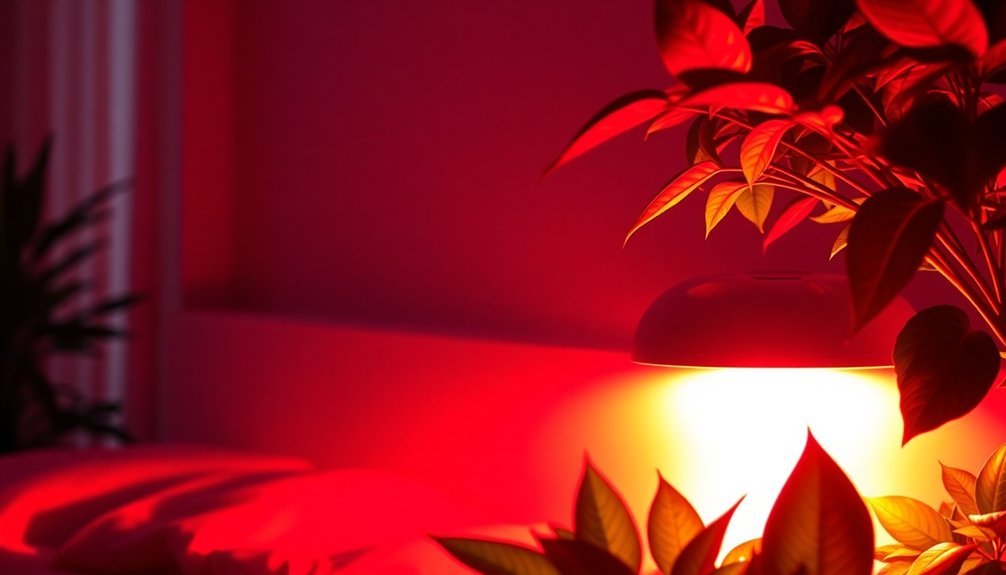
With the growing popularity of red light therapy, various devices have emerged to cater to different needs and preferences. Each device offers unique benefits, making it essential to choose one that aligns with your goals.
Whether you're looking for targeted relief or whole-body treatment, the options are plentiful.
Here's a quick overview of the types of devices available:
- Handheld Devices: Compact and portable for targeted sessions.
- Full-Body Panels: Ideal for extensive coverage in your treatments.
- Ambient Light Devices: Create a calming atmosphere by diffusing light uniformly.
- Combination Devices: Feature multiple wavelengths, including short red and near-infrared (NIR) light.
- Customizable Wavelengths: Some allow you to adjust the wavelengths to suit your specific needs.
These devices typically use short red LED light ranging from 630 to 700 nanometers or NIR light that penetrates deeper, between 700 and 900 nanometers.
You'll notice increased melatonin production, reduced inflammation, and improved circulation as you integrate red light therapy into your routine.
Plus, they're generally non-invasive and safe for home use, making them convenient additions to your wellness regimen.
Comparison With Natural Light
When you compare natural light to artificial light, the benefits of sunlight become clear.
Natural light helps regulate your circadian rhythms and supports healthy melatonin production, while artificial light can disrupt this balance, especially in the evening.
To optimize your melatonin levels, it's crucial to seek out the right exposure to natural light throughout the day.
Natural Light Benefits
Natural light plays an essential role in regulating your sleep patterns, particularly by influencing melatonin production. When you expose yourself to sunlight during the day, you're effectively signaling your body to prepare for rest at night.
The full spectrum of natural light, rich in blue wavelengths during the morning, keeps you alert and helps your body produce serotonin, a precursor to melatonin. As the day progresses, sunlight shifts to softer, red wavelengths, guiding your internal clock toward sleep.
To harness the benefits of natural light, consider the following:
- Get at least 30 minutes of outdoor activity daily, especially in the morning.
- Sit near windows to soak up sunlight if outdoor options are limited.
- Engage in short walks during the day to boost exposure to natural light.
- Understand that natural light cycles distinguish between day and night, enhancing sleep-wake cycles.
- Acknowledge that the dynamic changes in natural light intensity and color are crucial for sleep readiness.
Incorporating these practices can greatly improve your sleep quality by ensuring effective melatonin production.
Artificial Light Drawbacks
Artificial light poses important drawbacks compared to the benefits of natural light, particularly when it comes to melatonin production. Exposure to artificial light at night, especially blue light, effectively suppresses melatonin levels, which can disrupt your circadian rhythms.
Here's a comparison of different types of light and their effects on melatonin:
| Type of Light | Effect on Melatonin |
|---|---|
| Natural Light | Promotes melatonin production |
| Artificial Light | Suppresses melatonin |
| Blue Light | markedly suppresses melatonin |
Even low-intensity artificial light, like 6 lux, can hinder melatonin production. In contrast, filtered light allows for melatonin levels to remain more stable. The impact of blue light, emitted from your screens and LEDs, is even more pronounced, shifting your circadian rhythms drastically.
This suppression can lead to sleep disturbances and various health issues, such as obesity and diabetes. Reducing exposure to artificial light, especially before bedtime, is vital for maintaining healthy melatonin levels and ensuring restorative sleep. A cozy, dark environment free from screen time makes a big difference in your nighttime routine.
Optimal Evening Exposure
For ideal melatonin production, understanding light exposure in the evening is essential. The contrast between natural and artificial light plays a significant role in your body's ability to produce melatonin. Daylight can reach up to 10,000 lux, while artificial sources usually max out around 500 lux. This stark difference makes evening light exposure vital because diminishing natural light signals your pineal gland to ramp up melatonin production.
To optimize your evening exposure, consider the following:
- Natural light during the day aids in regulating circadian rhythms.
- Red light is less disruptive and promotes better sleep quality.
- Dim yellow and orange lights are preferable to cooler tones, enhancing melatonin production.
- Bright light exposure in the late afternoon can delay melatonin secretion.
- Timing your light exposure helps maintain a stable sleep-wake schedule.
Effects of Blue Light Exposure
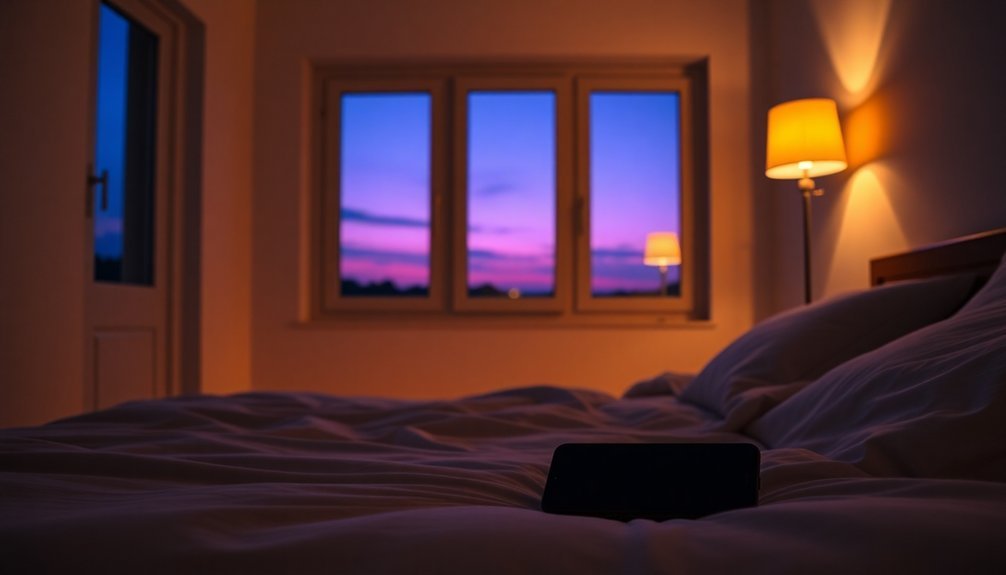
Blue light exposure at nighttime poses a considerable threat to melatonin production, essential for regulating your sleep-wake cycle. When you're exposed to blue light, especially in the 460-480 nm range, it can notably suppress melatonin release. This suppression might delay melatonin production and shift your circadian rhythms by as much as 3 hours.
Even dim blue light can interfere with melatonin secretion, negatively affecting your sleep quality. Compared to other wavelengths, like green light, blue light has a stronger impact on melatonin suppression. This exposure can disrupt your natural sleep-wake cycle, making it difficult for you to maintain an ideal 24-hour rhythm.
Additionally, blue light activates retinal cells that signal your brain to suppress melatonin, simulating daytime conditions and impairing your alertness and performance. To minimize this impact, you can take protective measures.
Switching to dim red lights for night illumination, avoiding bright screens for 2-3 hours before bed, and using blue-light-blocking glasses can help maintain healthy melatonin levels. By making these changes, you can enhance your sleep quality and regulate your circadian rhythms more effectively.
Experimental Insights on Melatonin
Experimental studies have shed light on the intricate processes governing melatonin synthesis and regulation. You'll find that melatonin production starts with tryptophan, which is converted into serotonin and then to melatonin through a series of enzymatic reactions.
The activity of serotonin-N-acetyltransferase (SNAT) peaks during darkness, leading to higher melatonin levels. Conversely, exposure to light reduces melatonin production by triggering signals that degrade SNAT.
Your circadian rhythm plays a significant role in this synthesis. The hypothalamic suprachiasmatic nucleus (SCN) directs melatonin production based on light conditions. Information about light travels from your retina to the SCN, which then orchestrates signals to the pineal gland to sync melatonin with the day-night cycle.
Additionally, neurotransmitters like norepinephrine are essential in triggering melatonin synthesis during the night. Disruptions such as light exposure at night or neurological conditions can interfere with this delicate balance.
Here's a snapshot of key insights:
- Melatonin starts from tryptophan.
- SNAT activity is significant during darkness.
- SCN acts as the master circadian clock.
- Norepinephrine stimulates melatonin production.
- Light exposure inhibits melatonin synthesis.
Benefits of Evening Red Light
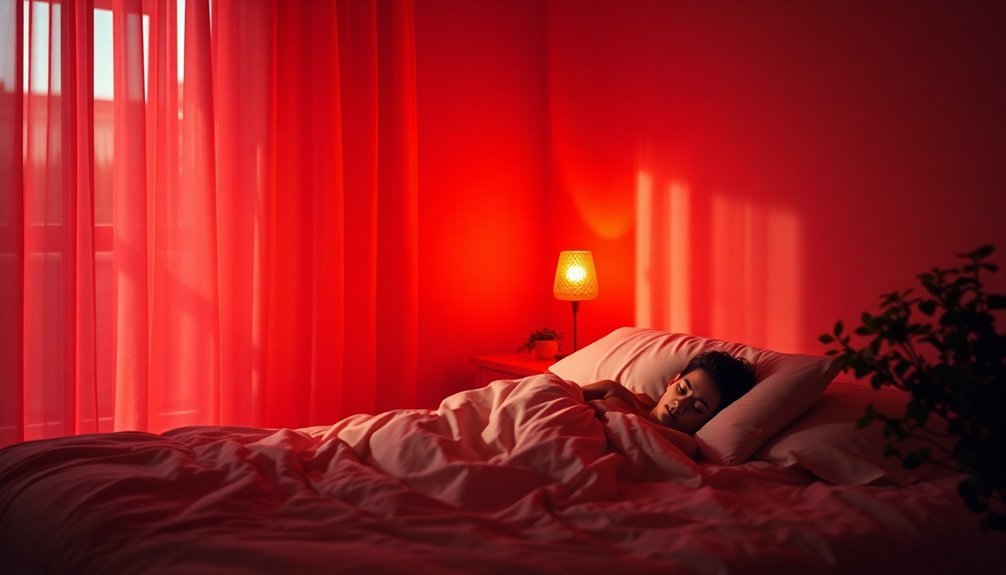
Embracing the calming effects of red light in the evening can greatly enhance your sleep quality and overall well-being. Using red and near-infrared light can help regulate your circadian rhythms, allowing for a natural sleep-wake cycle. Unlike blue light, red light doesn't suppress melatonin production, making it a perfect option for evening use. When you expose yourself to red light one to two hours before bedtime, you can considerably support melatonin levels and ease your shift into sleep.
Here's a quick overview of the benefits:
| Benefit | Details | Recommendation |
|---|---|---|
| Regulation of Circadian Rhythms | Aligns with your body's natural rhythms | Use in the evening |
| Support for Melatonin Production | Aids both pineal gland and cellular melatonin release | One to two hours before bed |
| Reduction of Stress & Anxiety | Enhances endorphin production for relaxation | Incorporate into nightly routine |
| Practical Considerations | Position light 6-12 inches from skin | Use a professional-grade device |
Maintaining Healthy Sleep Patterns
To maintain healthy sleep patterns, it's essential to pay attention to the timing and type of light you're exposed to throughout the day.
Natural light in the morning helps to reset your internal clock, while artificial light in the evening can interfere with melatonin production.
Light Timing Important
Light timing plays an essential role in maintaining healthy sleep patterns. By managing your exposure to light throughout the day and evening, you can greatly enhance your melatonin production and overall sleep quality.
Here are some key points to reflect on:
- Avoid bright light for at least two hours before bedtime to promote easier sleep onset.
- Dim the lights in your environment during this time to create a sleep-conducive atmosphere.
- Limit blue light exposure from devices before bed, as it can considerably affect melatonin levels and disrupt your ability to fall asleep.
- Embrace morning light exposure shortly after waking to help your body feel more alert and regulate your circadian rhythm.
- Keep your bedroom dark at night; this helps support melatonin production and reinforces stable sleep-wake cycles.
Natural Versus Artificial Light
Managing your light exposure isn't just about timing; it also involves understanding the difference between natural and artificial light and their impact on your sleep.
Natural light, especially during the day, plays a critical role in regulating your circadian rhythm. Exposure to bright daylight can reach up to 10,000 lux, greatly aiding in the production of melatonin at night, which ultimately improves your sleep quality and overall health.
On the other hand, artificial light, particularly blue light from screens and LEDs, can hinder this process. Exposure to these wavelengths at night can suppress melatonin levels and disrupt your sleep patterns, leading to issues like insomnia and reduced sleep quality.
Even dim artificial light can negatively impact your circadian rhythms, with as little as 8 lux being enough to cause disturbances.
To cultivate better sleep, aim for warm light sources in the evening and limit blue light exposure. Consider using dim red lights for night-time use and incorporate blue-blocking glasses, especially if you use screens before bed.
Frequently Asked Questions
Can Wearing Sunglasses at Night Help Melatonin Levels?
Wearing sunglasses at night might help block certain light wavelengths, but they aren't specifically designed for that. Instead, consider using blue-light-blocking glasses, which effectively enhance melatonin levels and improve sleep quality.
What Role Does Diet Play in Melatonin Production?
Your diet greatly impacts melatonin production. By consuming melatonin-rich foods like tart cherries, salmon, and nuts, you can naturally enhance your melatonin levels, promoting better sleep and overall health without relying on supplements.
Are There Any Supplements That Boost Melatonin Production?
Yes, melatonin supplements can boost your production, especially when taken 30 minutes to an hour before bed. Start with a low dose, and consult a doctor to guarantee safety and proper dosage for your needs.
How Do Stress Levels Affect Melatonin Production?
Stress levels greatly impact melatonin production. When you're stressed, heightened cortisol reduces melatonin synthesis, disrupting your body's natural rhythms. Managing stress is key to maintaining healthy melatonin levels and ensuring better sleep quality.
Can Melatonin Help With Jet Lag Recovery?
Yes, melatonin can help with jet lag recovery. It aids in adjusting your circadian rhythm, reduces symptoms like insomnia and daytime sleepiness, and enhances your ability to resynchronize with a new time zone effectively.
In Summary
To enhance your melatonin production, focus on exposure to red and near-infrared light in the evening. Avoid blue light, especially before bedtime, as it can disrupt your sleep cycle. By using red light therapy devices and timing your light exposure wisely, you can support a natural sleep pattern. Embracing these practices will not only help you sleep better but also improve your overall wellbeing. Remember, lighting plays an essential role in your nightly rest!





Leave a Reply